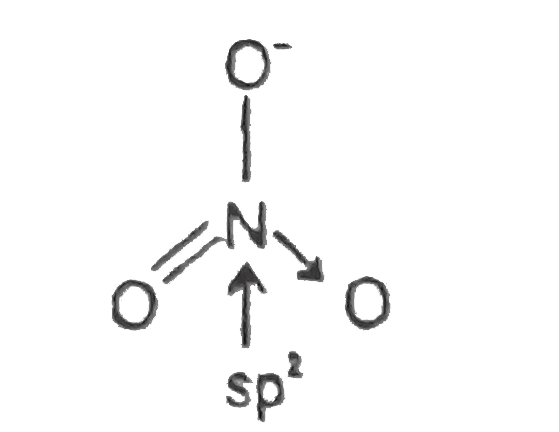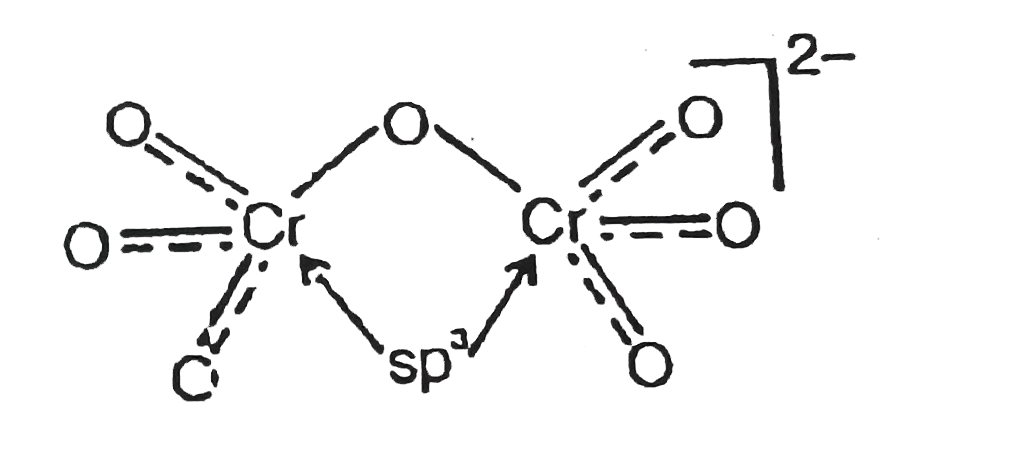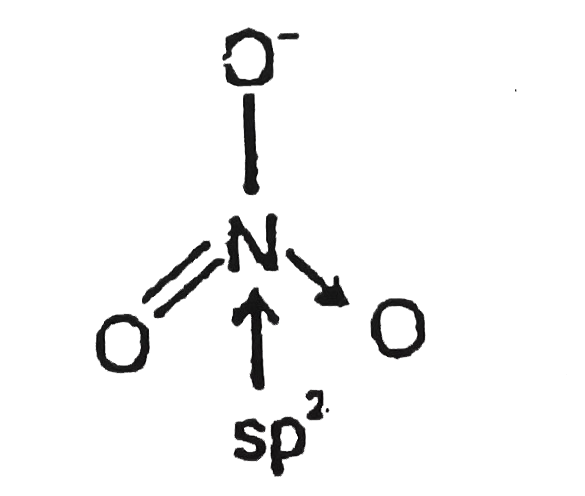Match the reaction in Column I with nature of the reactions/type of the products in Column II.
Column IColumn II(A)AgNO3(aq)+I2(s)(excess)+H2O(l)→(p)Redox reaction(B)CrO2−4(aq)+H+(aq)→(q)One of the products has trigonal planar structure(C)MnO−4(aq)+NO−2(aq)+H+(aq)→(r)Dimeric bridged tetrahedral metal ion(D)NO−3(aq)+H2SO4(aq)+Fe2+(aq)→(s)Disproportionation(t)Colour of one of the products is due to charge transfer spectrum
The correct Answer is:A→p,q,s ; B→r,t ; C→p,q ; D→p,t
(A)5AgNO3(aq)+30I2(excess)+3H2O→+vHIO3+−15Agl+5HNO3
It is disproportionation and redox reaction. NO−3 has planar structure.

(B)2CrO2−4+H+→Cr2O2−7+H2O

Cr2O2−7 has dimeric bridged tetrahedral metal ion.
The colour is due to charge transfer spectrum.
(C )NO−2 is being oxidised and MnO−4 being reduced according to the following reaction. So it is redox reaction. , 2MnO−4+5NO−2+6H+→2Mn2++5NO−3+3H2O

(D)Fe2+ is being oxidised and NO−3 being reduced according to the following reaction. So it is redox reaction, 3Fe2++NO−3+4H+→NO++3Fe3++2H2O
Fe2++NO++5H2O→[Fe(H2O)6NO]2+ (brown ring)
The colour is due to charge transfer spectrum.
Topper's Solved these Questions
Similar Questions
Complete the chemical equations :
MnO−4(aq)+H2O2(aq)+H+(aq)→
View SolutionColumn IColumn II(A)XeF4(s)+H2O(l)→(p)Show disproportionation reaction(B)P4(s)+OH−(aq)+H2O→(q)One of the products is a monobasic Lewis acid.(C)B2H6(g)+H2O(l)→(r)One of the products is a gas(D)Br2(g)+K2CO3(aq)→(s)One of the products has a trigonal pyramidal molecular structure (t)One of the gaseous products is used is used in Holme's singnals in sea .
View SolutionMatch the reactions listed in column (I) with the colour of the precipitate(s) listed in column (II).
Column IColumn II(A)Cu2+(aq)allow to stand for sometime−−−−−−−−−−−−−−−→(p)Brown(B)HotBi3+(aq)+C6H3(OH3)→(q)Brownish-red(C)Ag+(aq)+AsO3−4(aq.)→(s)Yellow(D)Mn2+(aq.)+2OH−(aq.)air−−→(s)White(t)Green
View SolutionMatch the reactions listed in column (I) with the colour of the precipitate(s) listed in column (II).
Column IColumn II(A)Cu2+(aq)allow to stand for sometime−−−−−−−−−−−−−−−→(p)Brown(B)HotBi3+(aq)+C6H3(OH3)→(q)Brownish-red(C)Ag+(aq)+AsO3−4(aq.)→(s)Yellow(D)Mn2+(aq.)+2OH−(aq.)air−−→(s)White(t)Green
View SolutionMatch the nature of aqueous solutions of the substances listed in Column I with the character listed in Column II.
Column IColumn II(A)KCN(aq)(p)Strongly basic(B)TiOH(aq)(q)Neutral(C)BeCl2(aq)(r)Weakly basic(D)NaNO3(aq)(s)Weakly acidic
View SolutionComplete the chemical equations :
MnO−4(aq)+S2O2−3(aq)+H2O(l)→
View SolutionThe reaction:
BaCl2(aq)+H2SO4(aq)→BaSO4(s)+2HCl(aq) is
View SolutionComplete the following chemical reaction equations :
(i) MnO−4(aq)+C2O2−4(aq)+H+(aq)→
(ii) Cr2O2−7(aq)+Fe2+(aq)+H+(aq)→
View SolutionComplete the following chemical equations :
(i) MnO−4(aq)+S2O2−3(aq)+H2O(l)→1
(ii) Cr2O2−7(aq)+Fe2+(aq)+H+(aq)→
View SolutionComplete the following chemical equations :
(i) MnO−4(aq)+S2O2−3(aq)+H2O(l)→1
(ii) Cr2O2−7(aq)+Fe2+(aq)+H+(aq)→
View Solution
